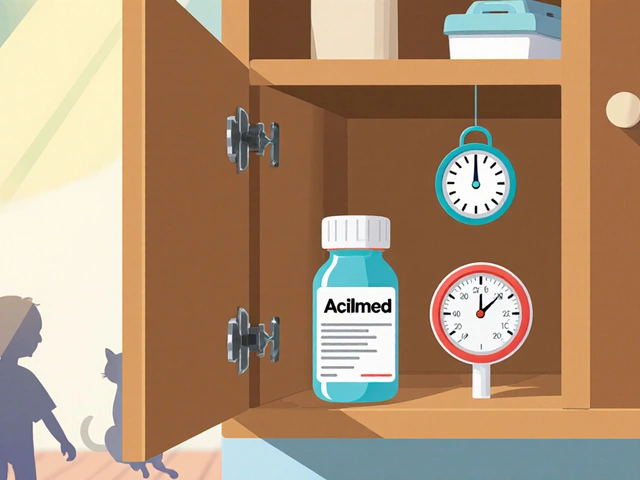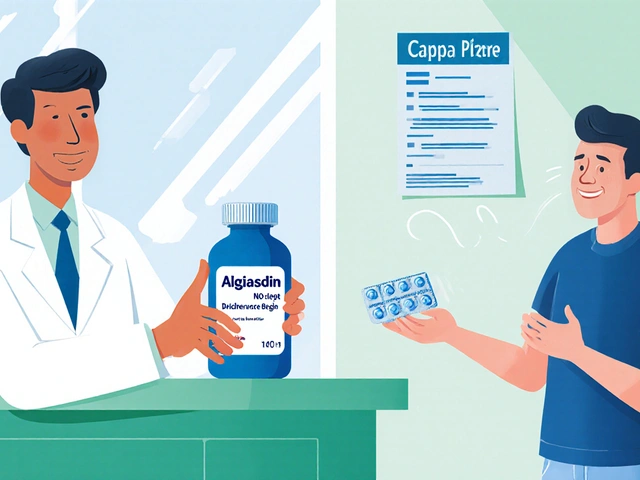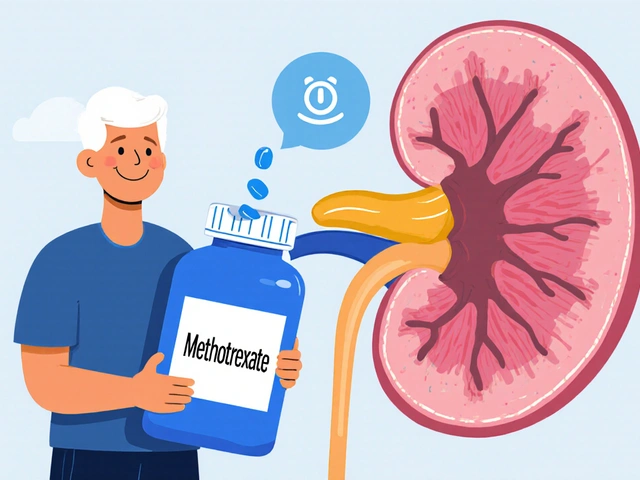
When you come out of the operating theatre, the last thing on your mind is a blood clot, but deep vein thrombosis (DVT) is a real threat that can turn a smooth recovery into a medical emergency. This guide walks you through the whole process - from checking your personal risk to choosing the right prevention tools and spotting early warning signs - so you can stay one step ahead after surgery.
Understanding DVT After Surgery
Deep Vein Thrombosis is a condition where a blood clot forms in the deep veins, usually in the legs, and can travel to the lungs causing a pulmonary embolism. It becomes more common after surgery because anesthesia, immobility, and tissue injury all tip the balance toward clot formation.
Surgeons classify post‑operative DVT risk based on the type of operation, patient age, and underlying health conditions. Orthopedic procedures, especially hip or knee replacements, sit at the top of the risk ladder, followed by abdominal, pelvic, and major cancer surgeries.
Assessing Your Personal Risk
Before you even step into the recovery room, your care team should run a quick Caprini score. This questionnaire adds points for factors like obesity, previous clot, active cancer, or hormonal therapy. A total above 5 signals high risk and usually triggers both drug and mechanical prophylaxis.
If you have a known clotting disorder such as Factor V Leiden, the score alone isn’t enough - your doctor may order a Venous ultrasonography pre‑operatively to rule out existing clots. The key is to get a clear picture of where you stand before the first dose of medication.
Pharmacologic Prevention Options
Anticoagulant medication forms the backbone of modern DVT prevention. Two big families dominate the market:
- Low Molecular Weight Heparin (LMWH) - given subcutaneously once or twice daily, with a predictable effect and lower bleeding risk than unfractionated heparin.
- Direct oral anticoagulants (DOACs) such as apixaban or rivaroxaban - taken as a pill, which many patients find easier to follow.
The choice depends on kidney function, bleeding risk, and the surgery type. For most orthopedic patients, a 10‑day course of LMWH followed by oral anticoagulation has become the standard.

Mechanical Prophylaxis Techniques
When drugs aren’t enough, or you have a high bleeding risk, mechanical methods step in. The two most common are:
- Compression stockings - graduated elastic garments that squeeze the calf and promote venous return. They should start as soon as the patient can tolerate them and stay on for at least 7‑10 days.
- Intermittent pneumatic compression (IPC) devices - sleeves that cyclically inflate, mimicking the natural muscle pump. These are especially useful in spine or neurosurgery where early walking may be delayed.
Both methods are safe, low‑cost, and have been shown to cut clot rates by 30‑40% when used correctly.
Combining Strategies for Best Outcomes
Evidence shows the strongest protection comes from a combination of drug and mechanical tactics, tailored to the individual’s risk profile. A typical protocol for a high‑risk knee replacement might look like this:
| Aspect | Pharmacologic (e.g., LMWH) | Mechanical (e.g., IPC) |
|---|---|---|
| Primary action | Inhibits clotting cascade | Enhances venous return |
| Onset | Within hours | Immediate when device applied |
| Bleeding risk | Moderate to high | None |
| Patient compliance | Depends on dosing schedule | Requires device setup |
When you pair LMWH for the first five days with IPC after each period of immobility, you get a “double‑cover” effect that dramatically lowers clot formation without pushing bleeding rates up.
Monitoring and Early Detection
Even with the best plan, you should keep an eye out for warning signs. Look for:
- Pain, swelling, or warmth in the calf
- Redness or a visible vein
- Sudden shortness of breath, chest pain, or rapid heartbeat - possible pulmonary embolism
If any of these appear, contact your surgical team right away. A bedside Venous ultrasonography can confirm a clot within minutes, allowing prompt treatment.

Common Pitfalls and How to Avoid Them
Several mistakes creep into post‑operative care:
- Skipping early mobilization - getting out of bed and walking a few steps every hour dramatically reduces stasis.
- Choosing the wrong dose of anticoagulant - always adjust for weight and kidney function; ask the pharmacist to double‑check.
- Improper fitting of compression stockings - a too‑tight garment can cause skin breakdown, while a loose one does nothing.
- Discontinuing prophylaxis too early - many clots develop after discharge; follow the prescribed duration, often 2‑4 weeks for high‑risk patients.
Having a clear, printed checklist from your surgeon helps keep these points in front of you.
Quick Checklist for Post‑Surgery DVT Prevention
- Ask for your Caprini score result and understand your risk level.
- Start the prescribed anticoagulant within 12‑24 hours if approved by your doctor.
- Wear properly fitted compression stockings daily.
- Use IPC devices whenever you’re immobile for more than 30 minutes.
- Begin gentle leg exercises and short walks as soon as pain allows.
- Monitor for calf pain, swelling, or breathing changes and report them immediately.
- Complete the full course of medication even after you feel fine.
- Schedule a follow‑up visit or tele‑check to confirm you’re still on track.
Frequently Asked Questions
How long after surgery does DVT risk stay high?
The risk peaks in the first 5‑7 days but can linger for up to 4 weeks, especially after major orthopedic procedures. That’s why many doctors prescribe prophylaxis for at least two weeks post‑discharge.
Can I take my regular aspirin instead of prescription anticoagulants?
Aspirin helps a bit, but for high‑risk surgeries it’s not strong enough. Studies show LMWH or DOACs cut clot rates by about half compared to aspirin alone.
Are compression stockings uncomfortable?
If they’re the right size and class (usually 15‑30 mmHg for postoperative use), most patients find them snug but tolerable. Have a nurse measure your calf circumference to get a proper fit.
What should I do if I notice swelling in my calf?
Don’t ignore it. Call your surgical team right away. They’ll likely order a duplex ultrasound to check for a clot and may adjust your medication dose.
Is it safe to travel by plane after surgery?
Air travel increases stasis, so if you must fly within two weeks, stay hydrated, take off your shoes, and do calf exercises every hour. Adding an IPC device for the flight can further lower risk.





There are 8 Comments
Drew Waggoner
Missing your DVT meds is a fast track to heartbreak and a possible fatal clot.
Brian Van Horne
Your comprehensive, step‑by‑step protocol exemplifies exemplary prophylactic stewardship, rendering postoperative care both systematic and efficacious.
Norman Adams
Oh, because physicians love to reinvent the wheel, they insist on redundant scoring systems that merely state the obvious: you’re more likely to clot if you’re older and immobile.
Karla Johnson
Post‑operative DVT prevention is not merely a checklist, it is a critical component of a successful recovery.
First, every patient should receive a personalized risk assessment, preferably using the validated Caprini scoring system.
The score directs clinicians toward appropriate pharmacologic and mechanical measures, and a score above five unequivocally signals the need for combined therapy.
Second, low‑molecular‑weight heparin remains the cornerstone for high‑risk orthopedic procedures, due to its predictable pharmacodynamics and manageable bleeding profile.
Third, direct oral anticoagulants offer convenience, but their use must be calibrated to renal function and potential drug interactions.
Mechanical prophylaxis, such as graduated compression stockings, should be fitted correctly; an ill‑fitted garment can cause skin breakdown without delivering benefit.
Intermittent pneumatic compression devices are especially valuable when early ambulation is delayed, as they mimic the natural calf muscle pump.
Evidence demonstrates that a dual approach-pharmacologic plus mechanical-reduces clot incidence by up to forty percent compared with either modality alone.
Early mobilization, even in small increments, dramatically decreases venous stasis, and patients should be encouraged to perform ankle pumps and foot circles hourly.
Patients must also be educated on warning signs: calf tenderness, swelling, sudden dyspnea, or chest discomfort require immediate medical attention.
Ultrasound can rapidly confirm a clot, allowing timely escalation of therapy before a pulmonary embolism develops.
Discontinuation of prophylaxis too early is a common pitfall; most guidelines recommend continuation for at least two weeks post‑discharge in high‑risk cohorts.
Weight‑based dosing of anticoagulants is essential to balance efficacy with bleeding risk, and pharmacists should verify each prescription.
Finally, a printed, patient‑friendly checklist improves adherence, ensuring that no step-from medication timing to compression stocking wear-is overlooked.
By integrating these strategies into a cohesive protocol, clinicians can safeguard patients against the silent threat of postoperative DVT.
Linda A
Reading your thorough exposition evokes the timeless dance between vigilance and complacency; each precaution is a stanza in the ode to recovery, reminding us that neglect is the true antagonist.
Joe Moore
Look, the real reason we’re pushin' these meds is the pharma lobby’s secret agenda – they want us hooked on brand‑name anticoagulants forever. They defnitely dont want ya to use cheap generic or natural options ‘cause that’d cut their profits.
Ayla Stewart
I understand your concerns, but the guidelines are based on large studies and aim to keep patients safe; following them usually leads to the best outcomes.
Poornima Ganesan
Let’s be clear: the Caprini score isn’t a suggestion, it’s a mandatory tool. If you’re under ten points you’re still at risk, and ignoring the mechanical prophylaxis is a negligent mistake that many clinicians make, thinking it’s optional.
Write a comment
Your email address will not be published. Required fields are marked *